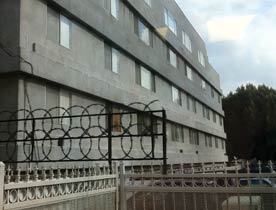Building Conditions Deteriorate
Geraldine Davis moved into 1520 Sedgwick in the ’70s, soon after it was built. “This place was like a hotel. It was beautiful,” she said. But pride has given way to anger in recent times. When Karasick took over, the floors in the building’s lobby and corridors were rarely cleaned, Davis says, and heat and hot water outages became more common. The two elevators—troublesome for years—began to break down more regularly and stay broken for weeks at a time. The management company and its staff were slow to make repairs, Davis added, and the lock on the front door was often broken, allowing strangers in. “There have been people sleeping in the stairwells,” she said.
Sitting in her living room one recent evening, the hum of the Major Deegan Expressway audible below, Gloria Robinson, the building’s tenants association president, echoed many of Davis’s complaints. Contacting management about a problem in your apartment was like “talking to the wind,” she said.
Several tenants, sick of the neglect, moved out, but Robinson stayed put.
“I like it right here in the Bronx,” she said. “And I like this building and my apartment, I really do. … If you like where you live, you’re not going to go anywhere. You just hope there’s some improvement, and you keep fighting for it.”
In a Times article published in January 2010, the director of the company that controls the management firm brushed off tenants’ concerns, insisting that the building was “immaculate at all times.” But in a little over a year, the number of housing code violations at 1520 Sedgwick recorded by HPD shot up from 82 to 598, according to the article.
“It’s sort of amazing how quickly this all panned out exactly as we feared,” Levy said. “We met Karasick before . . . and begged him not to do this deal. We said, ‘We don’t understand your financing, we don’t understand your numbers,’ and he said, ‘I know what I’m doing.’ He’s a billionaire and we’re just these organizers from UHAB, and you start to think maybe he does know what he’s doing. But he didn’t.”
Hope for a Brighter Future?
Last fall, with Karasick missing mortgage payments, a new group, Workforce Housing Advisors and its Boston-based partner, Winn-Residential, bought the building’s mortgage for $6.2 million, using a $5.6 million loan from the city. The loan was financed by a new $750 million city program designed to maintain physically and financially strained buildings and help stabilize neighborhoods.
“We are putting our financial power to work with owners and lenders to restructure buildings’ financing to a sustainable level and in doing so preserving and keeping affordable our city’s housing stock,” said then-HPD Commissioner Rafael E. Cestero in a statement at the time. The New York City Council, meanwhile, committed $3 million to help with improvements inside 1520.
Workforce, whose staff have close ties to HPD and the city’s Housing Development Corporation (HDC), immediately foreclosed on the building, and a receiver has taken over the day-to-day operations. John A. Crotty, a Workforce founding member and former HDC employee, said the organization is committed to affordable housing.
“When you work with the people who represent these buildings, who live in these buildings, and come from these buildings . . . you understand that these are people and homes,” Crotty said. “When you’re a private equity person, these are financial assets that float around, and do well or don’t do well, and whatever happens, happens. It totally ignores the human consequence of the action.”
A foreclosure auction will likely be held this year. If there’s no bid higher than what Workforce is owed, Workforce could soon own the building.
In a statement, Schumer said the news was a “huge victory for Sedgwick residents that will serve as a model for preserving affordable housing throughout New York City.” He added: “The message here is clear: residents should not be used as pawns for predatory equity investors to make quick profits.” (The building wasn’t Karasick’s only Bronx acquisition; in 2007 his group purchased Robert Fulton Terrace and Fordham Towers for $44 million. Both had just lost their Mitchell-Lama status and both have now been foreclosed on.)
The tenants themselves, disappointed so many times before, remain cautious. “Everything is just a bit up in the air,” Robinson said, noting that the management office downstairs is still empty. “I’m just hoping there will be some improvements soon, real soon.”
Davis was blunter: “We really don’t know what’s happening with the building. Ain’t nobody telling us right now.”
Tenants say they’ve already had discussions with Workforce about the possibility of turning 1520 into an affordable cooperative down the road, with UHAB’s help and guidance.
Serrano says that he’ll support whatever decision they make, and stressed how important it was that they stay organized. But he’s hopeful for a positive outcome: “Historically, the building played an important role in hip-hop and now it may have [also] played a role in the preservation of good buildings.”





Comments